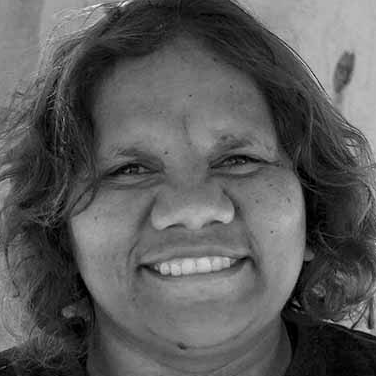| Artist | Judith Anya Samson |
|---|---|
| Title | Emu Tracks to Puntawarri |
| Year | 2021 |
| Medium | Acrylic on linen |
| Dimensions | 91 × 91 cm |
| Art Centre | Martumili Artists → |
Out of stock
Judith Anya Samson

I was born in Hedland, Port Hedland seaside, but I moved to Jigalong community with my nanna [Dadda Samson] and my pop. Then we moved to desert, to Puntawarri, Well 17. I was still a young girl, still crawling in the desert. It was nice there. Some other families lived there with us. We had some farm, some vegetables. We went schooling in Puntawarri at the school, learning ‘two way’ [refers to teaching in both Martu Wangka and English, with a focus on local cultural and ecological knowledge]. We used to go and get some parnajarrpa (goanna) and turkey. We had a Toyota truck. We go hunting at the desert. Some people there still, but they gotta build some new houses and then we going back to [live in] Puntawarri. My nanna’s sister had a house here in Newman, so we used to come and visit. I did high school here in Newman. Now I move between Jigalong and Newman. My nanna is living in Jigalong. I started to do painting here at Martumili when I was a young girl. I been help my nanna painting, we were painting Puntawarri one. My nanna was teach me to paint. I work with Martumili now. I help sell the painting, and photograph and catalogue them. I work for KJ (Karninyanpa Jukurrpa ranger group) mob in Jigalong too.
Artist statement
Emu go to the springs to have a drink of water and then move on to the next one.
Puntawarri is an important cultural area, as well as the site of a now abandoned community, a waterhole, creek and lake. Puntawarri is located on the middle stretches of the Canning Stock Route and east of the Jigalong Aboriginal Community, where Judith Anya Samson grew up with her grandmother and senior Martumili Artist Dadda Samson. Both artists continue to live there today. Puntawarri lies within Judith’s ngurra (home Country, camp) through her mother’s family, and as a young girl she frequently travelled and hunted with her family in this area, learning the stories for this Country. Depicted in this work are the tracks of a group of karlaya (emus) on their way to Puntawarri waterhole, searching for kapi (water).

